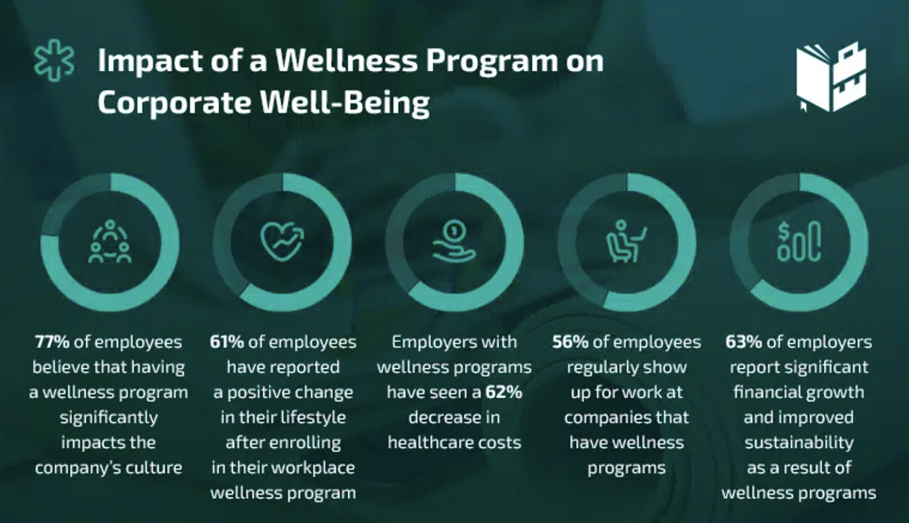The Role of Technology in Enhancing Corporate Wellness Programs

In today's world, technology seamlessly integrates into our daily routines, permeating every aspect of our lives — including the workplace. The corporate landscape has witnessed a transformative shift fueled by technology, reshaping not just how we work but also how we value and address employees’ well-being.
The impact of technological advancements on corporate wellness programs is undeniable, and it’s prompting a significant paradigm shift in how employers perceive and prioritize employee health. The substantial influence of technology on individuals' physical, mental, and social well-being is encouraging more companies to embrace innovative solutions to augment their wellness initiatives — and you should take a look.
Advantages of Incorporating Technology to Enhance Corporate Wellness Programs
By 2026, the global corporate wellness market is projected to reach $74.11 billion. That’s because, by incorporating technology into corporate wellness, companies know they can drive better outcomes. Here’s how technology can help improve your workplace wellness:
Convenience
Unlike traditional wellness programs that may require physical attendance at specific locations or adherence to fixed schedules, technology allows employees to engage in wellness activities from virtually anywhere. Fitness apps, online resources, and virtual coaching platforms provide employees with the flexibility to choose when and where they participate, aligning wellness efforts with their busy schedules and diverse lifestyles.
Cost-effectiveness
Traditional wellness programs often incur expenses related to venue rentals, printed materials, and on-site facilitators. Technology, however, eliminates many of these overhead costs. Virtual coaching sessions, online resources, and digital platforms provide a scalable and cost-efficient means of delivering wellness content to a large and diverse employee base.
Increased Employee Engagement
Employees who actively engage in wellness activities are likely to experience improved physical and mental well-being. This, in turn, leads to lower rates of absenteeism and presenteeism. In fact, according to a Gallup study, businesses with highly engaged employees see an 81% difference in absenteeism and 14% increase in productivity. The cumulative effect is a more productive workforce, contributing to a positive and vibrant work environment that ultimately benefits both employees and the organization.

Tracking and Analysis
Corporate wellness programs also revolutionize the way employers understand and optimize employee well-being initiatives. The continuous stream of real-time data provided by these technologies allows employers to gain immediate insights into the well-being of their workforce, enabling proactive interventions and targeted support. For example, analyzing participation rates in specific wellness challenges or tracking the impact of stress management resources allows companies to tailor their programs to better suit the needs and preferences of their employees.
Actionable Feedback
Many wellness technologies offer real-time feedback, providing employees with immediate insights into their health and well-being. With real-time feedback, employees can make informed decisions, adjust their wellness routines on the fly, and receive immediate support through virtual coaching. The dynamic interaction creates a sense of accountability, motivation, and personalization, enhancing engagement in fitness and stress management goals. From an organizational standpoint, real-time feedback positions companies to optimize their wellness strategies, creating a workplace culture that prioritizes health and adapts to the evolving needs of its employees.
8 Advanced Technologies Transforming Corporate Wellness Initiatives
Let’s look at the most innovative technologies revolutionizing wellness for businesses:
1. Wearable Devices
With the integration of wearable devices and health apps, employees gain the ability to monitor their health metrics in real time. This data not only fosters self-awareness but also allows for the customization of wellness plans based on individual needs and preferences. Employees can access tailored exercise routines, nutritional guidance, and stress management strategies, ensuring that the wellness program aligns with their unique health goals and addresses specific areas of concern.
2. Mobile Applications
The on-the-go nature of mobile applications makes it possible for employees to engage in healthy habits, track their nutrition, and monitor stress levels. Often, mobile applications also provide mindfulness exercises, which can dramatically improve mental health. With personalized information, helpful built-in reminders, and tips on how to lead a healthy life, mobile applications are not only making an impact on an individual level but are also contributing to a culture of overall well-being within the workplace.
3. Online Health Assessments
Online health assessments offer employees a comprehensive and personalized analysis of their health status. By gathering information on various health metrics, lifestyle choices, and risk factors, these assessments provide a baseline understanding that forms a foundation for targeted wellness interventions.
4. Virtual Wellness Classes
From fitness workouts and yoga sessions to meditation and nutrition workshops, virtual wellness classes cater to various aspects of holistic health, providing employees with convenient opportunities to prioritize their well-being. Live sessions often provide opportunities for real-time interaction with instructors and fellow participants, creating a virtual space for shared wellness experiences. This sense of camaraderie not only boosts motivation but also contributes to a positive and supportive workplace culture, even in a remote or hybrid work environment.
5. Gamification
Technology also introduces the element of gamification to wellness programs, enhancing engagement and making the overall experience more enjoyable. Gamified challenges, virtual competitions, and rewards systems not only motivate employees to participate consistently but also add an element of fun to the wellness journey. This approach makes wellness activities feel less like a chore and more like an adventure, contributing to sustained engagement over time.
6. Telemedicine
The integration of telemedicine into corporate wellness programs enables employees to connect with healthcare providers through virtual consultations, reducing the need for in-person visits and time spent commuting to medical facilities. This accessibility extends to mental health support, with virtual therapy sessions addressing things like stress and anxiety.
Integrated with wearables and health apps, telemedicine facilitates ongoing health monitoring and personalized interventions for chronic disease management. Not only does telemedicine improve overall well-being, but its cost-effective nature also supports the feasibility of comprehensive wellness programs by reducing healthcare-related expenses.
7. Health Management Platforms
With health management platforms, employees can gain access to health insights and goal tracking to actively manage their wellness journey. Health management platforms also enable employers to streamline wellness programs, utilizing data analytics to assess participation rates, measure the impact of initiatives, and tailor programs to the specific needs of their workforce. They can help deliver personalized and interactive content, fostering employee engagement and participation.
8. Virtual Reality
Leveraging virtual reality technologies opens up possibilities for creating immersive and interactive health and wellness experiences, including virtual meditation sessions. With virtual reality, employees can engage in a range of virtual activities and challenges designed to enhance their well-being. Utilizing virtual reality for stress management introduces a fun and engaging approach for employees to unwind and relax, contributing to a holistic and enjoyable wellness program.
Balancing Wellness Tech Integration and Privacy
While incorporating technology solutions for corporate wellness programs has the potential to greatly enhance the employees’ experiences, it must be balanced with safeguarding employees’ data and privacy. Compliance with data regulations like GDPR, HIPAA, or relevant laws is particularly important. Transparent data policies also play a pivotal role in building trust, outlining the usage and access of wellness data.
Anonymization and aggregation techniques add an extra layer of privacy, allowing organizations to derive insights without compromising individual identities. Additionally, by using consent and opt-in mechanisms, employers can empower employees to control their participation, ensuring informed decisions about data sharing. Encryption and stringent security measures safeguard the confidentiality of health information, preventing unauthorized access.
We Can Help You Achieve Maximum Engagement and Impact
With CoreHealth, businesses can seamlessly integrate various wellness initiatives — from fitness challenges to mental health resources — into a unified, user-friendly platform. Our robust technology allows for personalized wellness experiences, enabling you to tailor programs to meet individual employee needs.
CoreHealth's analytics and reporting tools provide valuable insights into program effectiveness, allowing businesses to make data-driven decisions for continuous improvement. Our focus on data security and compliance also ensures that employee privacy is always prioritized, all while promoting a culture of well-being among your workforce.
Ready to get started? Talk to one of our technology experts today!
About The Author
CoreHealth Marketing
CoreHealth Technologies Inc. is a total well-being technology company trusted by global providers to power their health and wellness programs. Our wellness portals help maximize health, engagement, and productivity for 3+ million employees worldwide.




